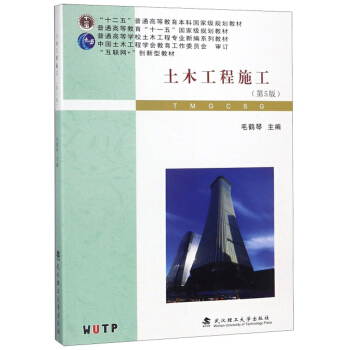无损检测专业英语 / 高等工科院校无损检测专业规划教材
作者: 张小海
出版时间:2012年
出版社:机械工业出版社
- 机械工业出版社
- 9787111347965
- 173016
- 0045156962-8
- 16开
- 2012年
- H319.4
- 检测类
- 本专科
序
丛书序言
前言
Chapter 1 Quality Control and NDT
1.1 NDT in Industry
1.2 NDT in Everyday Life
1.3 History of NDT
1.4 Understand the NDT Choices
1.5 Reliability of NDT
1.6 International Organizations of Quality Control and NDT
Words and Phrases
Notes
Exercises
Appendix Ⅰ 质量控制常用术语的中英双解
Appendix Ⅱ 国外主要无损检测学术机构、组织介绍
Chapter 2 Discontinuities-Origins and Classification
2.1 Primary Production of Metals
2.2 Casting
2.3 Cracks
2.4 Welding Discontinuities
2.5 Discontinuities Resulting from Plastic Deformation
2.6 CorrosionInduced Discontinuities
2.7 Operationally Induced Discontinuities-Fatigue Cracking
2.8 Operationally Induced Discontinuities-Creep
2.9 Operationally Induced Discontinuities-Brittle Fracture
2.10 Geometric Discontinuities
2.11 Summary
2.12 Indications: False, Nonrelevant, Relevant
Words and Phrases
Notes
Exercises
Appendix Ⅰ 缺陷有关术语的中英双解
Appendix Ⅱ 科技英语语法特点
Chapter 3 Radiographic Testing
3.1 Introduction
3.1.1 Historical Background
3.1.2 Advantages and Disadvantages
3.2 Theory and Principles
3.2.1 Basic Principles
3.2.2 X Rays, GrenzRays, and γRays
3.2.3 A bsorption and Scattering of XRays in Matter
3.2.4 Recording the XRay Image
3.2.5 X Ray Image Quality
3.3 Radiographic Technique
3.4 Equipment and Accessories
3.4.1 XRay Generators
3.4.2 Image Quality Indicators, Penetrameters
3.5 Applications
Words and Phrases
Notes
Exercises
Appendix Ⅰ 射线检测常用术语的中英双解
Appendix Ⅱ 科技英语常用词缀
Chapter 4 Ultrasonic Testing
4.1 Introduction
4.1.1 Historical Background
4.1.2 Advantages and Disadvantages
4.2 Theory and Principles
4.2.1 Wave Propagation
4.2.2 Ultrasonic Waves
4.2.3 Specific Acoustic Impedance
4.2.4 Reflection and Transmission at Boundaries
4.2.5 Wave Mode Conversion at Boundaries
4.2.6 Beam Attenuation
4.2.7 Pulse Shape and Beam Shape
4.3 Ultrasonic Techniques
4.4 Equipment and Accessories
4.4.1 Ultrasonic Transducers
4.4.2 Pulse Echo Display System
4.4.3 Automated Systems
4.4.4 Calibration and Reference Standards
4.5 Applications
Words and Phrases
Notes
Exercises
Appendix Ⅰ 超声检测常用术语的中英双解
Appendix Ⅱ 无损检测常用的缩略语
Chapter 5 Magnetic Particle Inspection
5.1 Introduction
5.1.1 Historical Background
5.1.2 Advantages and Disadvantages
5.2 Theory and Principles
5.2.1 Basic Principles
5.2.2 nle Hysteresis Loop and Magnetic Properties
5.2.3 Electrical Current and Electrical Powder
5.2.4 Demagnetisation
5.3 MPI Techniques
5.3.1 Magnetization Techniques
5.3.2 Magnetic Flow Techniques(Indirect)
5.3.3 Current Flow Techniques(Direct)
5.3.4 Coil Technique
5.3.5 Central Conductor Technique
5.3.6 Continuous and Residual Techniques
5.3.7 Color and Fluorescence
5.3.8 Summary of Technique Choices
5.4 EquiDment and Accessories
5.4.1 Stationary Units
5.4.2 Mobile and POrtable Units
5.4.3 Electromagnetic Yoke
5.4.4 Permanent Magnets
5.4.5 Black Lights
5.4.6 Flux Direction Indicators
5.4.7 AC Demagnetizing Coils
5.4.8 Magnetic Ink
5.5 Applications
WordS and Phrases
Notes
Exercises
Appendix Ⅰ 磁粉检测常用术语的中英双解
Appendix Ⅱ 无损检测技术常用的物理量纲及英语表达
Chapter 6 Eddy Current Testing
6.1 Introductinn
6.1.1 Historical Background
6.1.2 Advantages and Disadvantages
6.2 Theory and Principles
6.2.1 Basic Principles
6.2.2 Magnetic Induction(Self and Mutual)
6.2.3 Coil Impedance
6.2.4 Eddy Current Density and Skin Depth
6.3 Eddy Current Testing Techniques
6.3.1 Impedance Analysis Method
6.3.2 Other EC Methods
6.4 Equipment and Accessories
6.4.1 EC Transducers(Probes)
6.4.2 Eddy Current Instruments
6.5 Applications
Words and Phrases
Notes
Exercises
Appendix I 涡流检测常用术语的中英双解
Appendix II 常用数学符号及表达式
Chapter 7 Penetrant Testing
7.1 Introduction
7.1.1 Historical Background
7.1.2 Advantages and Disadvantages
7.2 Theory and Principles
7.2.1 Ruid Flow
7.2.2 Surface Tension


















